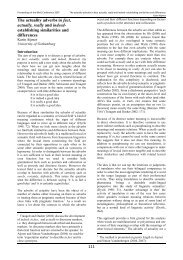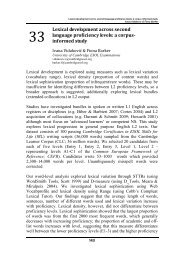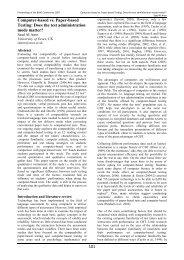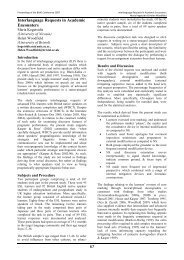Proceedings of the - British Association for Applied Linguistics
Proceedings of the - British Association for Applied Linguistics
Proceedings of the - British Association for Applied Linguistics
Create successful ePaper yourself
Turn your PDF publications into a flip-book with our unique Google optimized e-Paper software.
The Impact <strong>of</strong> <strong>Applied</strong> <strong>Linguistics</strong>: <strong>Proceedings</strong> <strong>of</strong> <strong>the</strong> 44th Annual Meeting <strong>of</strong> BAAL<br />
University <strong>of</strong> <strong>the</strong> West <strong>of</strong> England<br />
collocational transfer from ei<strong>the</strong>r source language to <strong>the</strong> L3 are part <strong>of</strong><br />
categories 8-14. Category 15 to 21 contain deviations, which one might<br />
prefer to describe as “infelicities”, such as contracted or shortened <strong>for</strong>ms,<br />
incorrect style and sign posting.<br />
Form Meaning Pragmatic<br />
Grapheme/morpheme 1 8 15<br />
Morpheme 2 9 16<br />
Lexeme 3 10 17<br />
Phrase 4 11 18<br />
Clause 5 12 19<br />
Sentence 6 13 20<br />
Text 7 14 21<br />
Table 17.1: Framework <strong>for</strong> analysis<br />
The results show that <strong>the</strong> main areas <strong>of</strong> CLI in <strong>the</strong> L3 from an L1 or L3 at<br />
both levels are transfers <strong>of</strong> <strong>for</strong>m, followed by transfers <strong>of</strong> meaning. The<br />
number <strong>of</strong> pragmatic transfers was too small to be statistically significant.<br />
Generally <strong>the</strong> amount <strong>of</strong> CLI found in <strong>the</strong> data is relatively low. Only<br />
between 2.26 and 4.62 words per hundred words that were produced can be<br />
traced back to transfer from <strong>the</strong> L1 or L2. These quantities, which vary<br />
according to stage <strong>of</strong> learning and task type, are similar to <strong>the</strong> ones found in<br />
o<strong>the</strong>r studies, such as Tremblay (2006), Lindqvist (2009), Marx (2000) and<br />
Piller (2001).<br />
The results suggest that in oral productions <strong>the</strong> L3 pr<strong>of</strong>iciency level is<br />
decisive <strong>for</strong> <strong>the</strong> use <strong>of</strong> o<strong>the</strong>r languages in at least two ways. First, <strong>the</strong><br />
amount <strong>of</strong> all types <strong>of</strong> CLI (from L1, L2 and L1/L2) decreases with<br />
increasing L3 pr<strong>of</strong>iciency. This result is in line with previous studies on<br />
transfer, which report that less pr<strong>of</strong>icient students present more CLI.<br />
Second, regarding <strong>the</strong> type <strong>of</strong> transfer, combined (<strong>for</strong>mal) CLI seems to be<br />
<strong>the</strong> main type <strong>of</strong> CLI in beginners. It seems that <strong>the</strong> rein<strong>for</strong>cing effect that<br />
<strong>for</strong>mal similarities between two languages can have is particularly strong in<br />
beginners. In intermediate students <strong>the</strong> L1 is <strong>the</strong> main source <strong>of</strong> transfer <strong>of</strong><br />
both <strong>for</strong>m and meaning.<br />
In <strong>the</strong> written productions, however, L3 pr<strong>of</strong>iciency does not seem to have<br />
a major influence on <strong>the</strong> quantity and quality <strong>of</strong> CLI. The figures are very<br />
similar at <strong>the</strong> two stages. L1 is <strong>the</strong> main source <strong>of</strong> transfer, followed by<br />
combined CLI and <strong>the</strong>n CLI from L2, transfer <strong>of</strong> <strong>for</strong>m is <strong>the</strong> main type <strong>of</strong><br />
transfer, followed by transfer <strong>of</strong> meaning.<br />
88







